
Standard Work
22 min read
5 Ways To Improve Quality Control in Manufacturing

In manufacturing, quality is everything.
Businesses need to focus on creating products that are high quality enough to meet or exceed the customer's needs if they want to be successful.
A company that puts out low-quality products won't be able to attain the level of customer satisfaction that will keep consumers coming back for more.
Quality control is a key component for the success of any business at any level, from small companies in the service sector up to giant corporations in the manufacturing industry.
But when it comes to the work of building and selling products directly to customers, nothing could be more important than quality.
The market for manufactured goods is very competitive, and quality is one of the biggest factors that will help to keep companies competitive. The benefits of maintaining policies and procedures focused directly on quality control and assurance are vast, and include:
- Securing repeat customers
- Getting referrals from current customers
- Growing customer satisfaction
- Improving safety standards
- Reducing liability from poor quality products
- Increased productivity, efficiency, and profitability
A company that's serious about manufacturing high-quality products must make dedicated efforts to monitor the quality of its output, assess the procedures that work well, and identify areas that could benefit from improvement.
There are tools available to help companies ensure they meet quality control standards, such as statistical process control. But there are other proactive measures companies can take as well. In this article, we will discuss five ways to improve quality control in manufacturing plants.
5 Ways to Improve Quality Control in Manufacturing
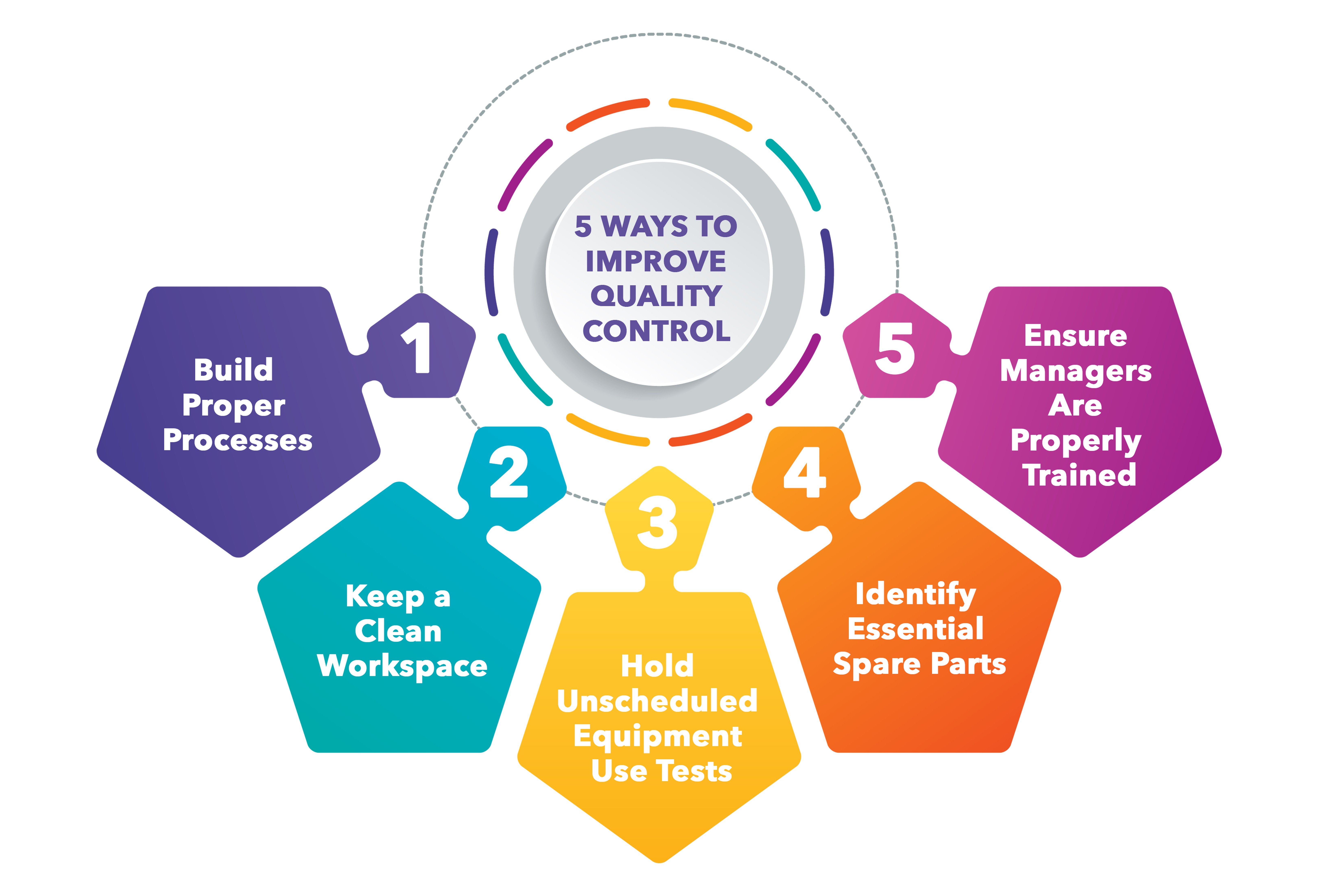
Manufacturing companies that seek to improve their rates of quality control need to take advantage of all the tools at their disposal.
There are proactive steps that businesses can take to prevent quality control issues before they happen and help them get a better perspective on the areas that need extra attention.
Having a firm understanding of the processes that lead to better quality products can help companies minimize their risk and enhance their overall operations.
And the great news is that most of these steps are common-sense policies that companies should be performing anyhow, as they will benefit more than just quality control performance.
-
Build Proper Processes
-
Keep a Clean Workspace
-
Hold Unscheduled Equipment Use Tests
-
Identify Essential Spare Parts
-
Ensure Managers Are Properly Trained
The rest of this article will take a closer look at each of these vital steps to ensure that companies can take every advantage to help them improve quality control in manufacturing.
1. Build Proper Processes to Ensure Quality Control
The first step in improving quality control is by strengthening the processes related to production. Streamlining these processes helps to ensure the final product meets the company’s criteria. Companies need to make sure the processes used to design, test, and produce products are done correctly.
Here are some tips and solutions on how to build better processes and improve quality control in manufacturing.
Set Quality Standards
Depending on the type of product your company manufactures, there may already be a specific set of quality standards that must be met during and after production. These standards are sometimes set by an industry association or by a government regulatory agency.
Sometimes companies will need to develop their own set of quality control standards. These should be a set of measurable items that can be applied across departments and should be specific to the point of production or service that is performed at that step.
Focusing on the most important aspects of production as it relates to quality control will allow companies to better streamline their processes around areas that can benefit the most from improvements.
Develop Operational Processes That Solve Problems
Once standards are in place and are being used as a yardstick to measure the quality of every step in the production process, companies can use those measures to pinpoint areas that need improvement.
To do this, companies need to outline a step-by-step process flow and include benchmarks that help to identify those specific areas that are falling short of attaining quality standards.
Look at the individual indicators of success or failure at those levels and work to identify ways to improve or streamline the process to improve quality outcomes overall.
Review the Outcomes
Companies should implement technology at every possible level to measure outcomes related to quality control. Using applications that pinpoint outliers in real-time can help companies get a better understanding of where the shortfalls lie and help them manage quality control issues as soon as they occur.
Reviewing quality, as a product moves through the production line, is important to recognize quality control issues at the level where they occur.
“We cut foundry scrap by 60%. Dozuki helps us get it right the first time.” — Sean C., Training Director, Mueller Water
This kind of real-time insight helps companies prevent small problems from becoming large-scale quality failures.
If an issue occurs with the raw materials but production is allowed to progress to the finished product, then companies face the waste involved with both materials and labor.
Utilize Feedback to Gather Valuable Information
Sometimes quality control issues are easy to spot, and other times companies need to rely on the data supplied from outside sources to gain a better perspective. Utilizing measurable feedback directly from customers is a great way to identify issues that may not be apparent at the production level.
Companies can use targeted surveys, product ratings, and reviews gathered from online sources to get a big picture of customer satisfaction as it relates to quality.
“Comments gave the line a voice. Feedback became fixes within days.” — Jose M., Mechanical Engineer, Knox Company
Empowering frontline operators to give input closes the feedback loop faster, which accelerates problem-solving and boosts quality outcomes. They can then use that data to calculate their net promoter score (NPS) and use that measurement to track success as it relates to improving quality control.
Use Data to Make Improvements
Gathering data and feedback is useless unless companies make an effort to organize that information into a useable body and then assess the ways they can improve quality control in the manufacturing process.
Even once issues have been identified and processes have been improved, quality control work should not stop. There needs to be constant oversight to strive for continuous improvement and guarantee that the highest quality products are being offered to customers.
2. Keep a Clean Workspace
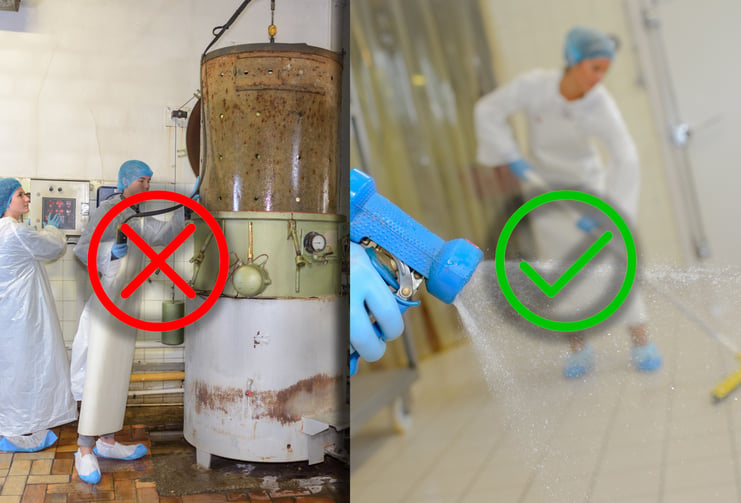
Keeping a clean environment on the factory floor and in every area should be a top priority. Not only does a messy and disorganized workspace increase the likelihood of potential injury, but it may lead to errors that could result in lowered quality.
Plant floors are already a dangerous environment, but when companies don’t prioritize cleanliness, it becomes even more so. Slips, trips, and falls are the number one cause of injury in workplaces, regardless of industry.
Companies who neglect cleanliness risk an increase in worker compensation claims and possible litigation, not to mention lowered productivity and the extreme danger to employee safety.
Here are some tips on how to ensure cleanliness is a top priority for every employee in a company, from top leadership down to production level employees.
Make Cleanliness a Top Priority
Every employee should understand the importance of cleanliness and organization before they ever step foot on the production floor. Making sure that maintaining a safe work environment is included as a top facet of a company's mission statement and values let employees know that their well-being is a top priority.
Post Visible Reminders
Visual aids help to reinforce the importance of cleanliness and remind employees that shortcutting is not an acceptable risk on the plant floor. A simple sign posted in the right area to remind employees to double-check cleanliness standards can help maintain consistency.
Delegate
Cleaning should not be an afterthought for the workforce, but should be a delegated task. Ensure employees know exactly what they’re responsible for before, during, and after shifts. Delegate leadership with the authority and responsibility to oversee compliance related to cleaning tasks.
Document
Documenting cleaning procedures helps not only clarify expectations but helps supervisors identify employees or situations where standards are not being met. Checklists should be implemented in appropriate situations to ensure there is no corner-cutting.
Utilize Supervisors for Oversight
Supervisors should be using checklists to verify that employees are upholding standards at every point during the production line.
Employees who are not upholding standards need to be counseled and retrained. The process should be documented by supervisors to create a trail that can be used if violations continue to occur.
Workforce Training
The importance of keeping a clean and trip-free work environment should be included as a training course for every new employee. Make sure the course is completed before any work begins and consider periodic retraining of employees to reinforce the importance of cleaning procedures.
Training should also include in-depth instructions and procedures related to complex or dangerous cleaning tasks. Make sure employees who are performing cleaning-related maintenance on heavy machinery are properly trained.
Stress the importance of cleaning up spills and messes as soon as they happen to prevent injury.
3. Hold Unscheduled Equipment Use Tests
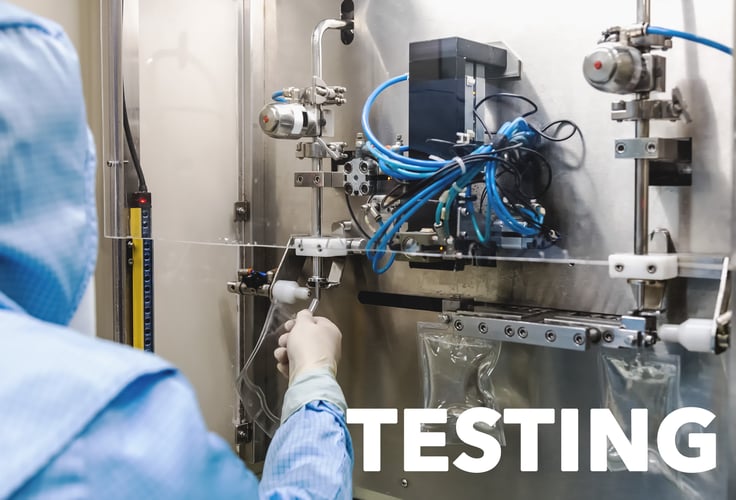
Companies should hold unscheduled use testing on machinery and equipment as a sort of pop quiz for safety. This process is essential for any company that wants to improve quality control measures in manufacturing and helps to ensure all workers are safe and efficient on the job.
Holding randomized testing allows companies an inside look at how well employees are complying with safety and quality control standards. It allows supervisors to demonstrate that there are strict requirements concerning these practices and reinforces the importance of consistently following safety measures.
Here’s how companies can implement unscheduled equipment use tests to improve quality control in the manufacturing process.
Make it Random
The important aspect of these tests is that they are unscheduled and unexpected. This ensures that companies get a true perspective of employees' knowledge and actions as it relates to safety, productivity, and adherence to standards.
Make it Regular
Although unscheduled, these tests should be a regular occurrence on the factory floor. Employees should be aware that their actions and training could be called into question at any moment. This will encourage them to consistently follow regulations and remain in compliance.
Pay Attention
Be sure to ask relevant questions of employees as a measure of how well they understand and implement quality control and safety procedures. Pay particular attention to adherence to safety measures and make note of areas where answers stray from standard procedures or employee training seems to be lacking.
Analyze Results
Testing serves little purpose without a full analysis of the measurable results. Be sure supervisors are thoroughly documenting when these tests are performed and the specific employees and procedures that are reviewed.
Especially take note of answers that fall outside of acceptable parameters and could lead to safety violations or lowered quality standards.
Make a Plan of Action
Once a random test has been completed, use the measurable results to form a plan of action to improve processes. If there is an obvious failure or lack of understanding on the part of the employees, be sure to follow up with specific steps to help rectify shortfalls.
Retrain Where Necessary
When random testing shows a lack of comprehension or adherence to safety guidelines, be sure to implement additional training opportunities for employees.
Most of the time, a direct lack of knowledge or understanding leads to improper adherence to guidelines. Employees deserve the opportunity to fully understand what is expected of them to perform their jobs successfully and safely.
Discipline When Needed
When testing shows a direct failure on the part of employees, and retraining opportunities have been afforded, supervisors need to follow up on progress. Retesting and reevaluation should occur shortly after to ensure improper actions have been corrected.
If employees continue to violate safety or quality standards, then supervisors should take direct action to hold workers accountable. Documented write-ups on sloppy or inattentive actions related to safety and standards should be clear and precise.
Avoid any opportunity for employees to misunderstand the consequences of repeated failures.
4. Identify Essential Spare Parts
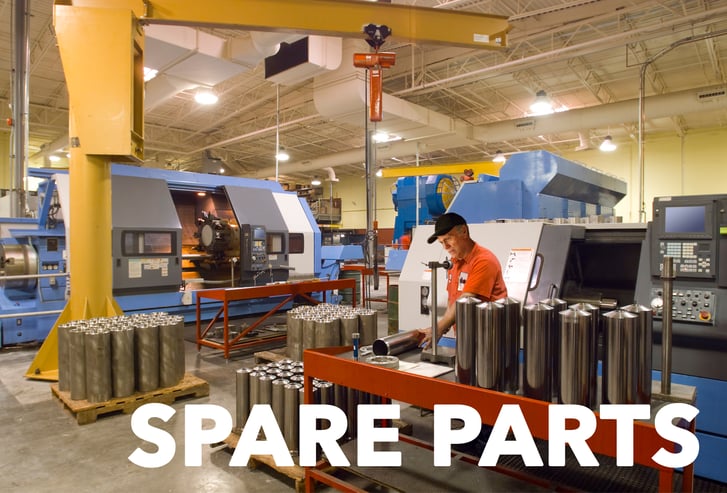
When a piece of machinery goes down in a manufacturing plant, it can cause severe disruptions in the production line. It's vital for companies to effectively manage a consistent inventory of spare parts to quickly and efficiently handle issues related to equipment failure.
Always having the proper spare parts is not only a smart business move, but it helps prevent injuries and accidents resulting from employees continuing to work with worn-out parts. This in turn leads to an increase in quality control in a manufacturing company because it ensures machinery is operating in peak conditions.
Here's how to ensure that your company never has to wait for an important part to show up before repairs can be made and that proper maintenance can be performed proactively to prevent breakdowns from occurring in the first place.
Perform Regular Maintenance
Regularly scheduled maintenance on machinery and equipment is vital to identifying worn-out parts or parts simply not operating at peak performance levels. Ensure preventative maintenance is being performed, and coach technicians to document and communicate when parts are in danger of failure.
Designate A Manager for Inventory Purposes
Delegate the tasks related to building and maintaining a solid inventory of spare parts. Be sure to set out a clear path of how to source required parts and how to document and maintain inventory counts. Provide oversight on these processes to ensure proper compliance, rotation, and storage of vital parts to ensure nothing is damaged or lost.
Be sure to consider the length of time it takes to receive replacement parts so that inventory levels support the possibility of multiple breakdowns.
Identify Essential Parts
Be sure to identify parts that are vital to maintaining productivity in the production line. There are distinct categories of inventory that should be considered when building a stockpile of replacement parts.
Consumables are mostly related to the raw materials used during production. Always be sure there is ample stock of these materials in the event of a shipping delay or damaged delivery. Ensure that proper rotation of these materials is constantly monitored.
Minimum critical parts are essential to a machine's operation and are typically specially designed for a specific piece of equipment. These parts may fail unexpectedly and need to be replaced with little to no notice.
Long-term parts are those that are guaranteed to wear out from repeated use and will eventually require replacement.
Ensure Employee Comprehension
Once an inventory of spare parts has been established, be sure employees know how to access them. This will ensure that employees understand that spare parts are always available and prevent workers from continuing to operate machinery that is dangerous or operates outside of quality control standards.
5. Ensure that Managers are Properly Trained
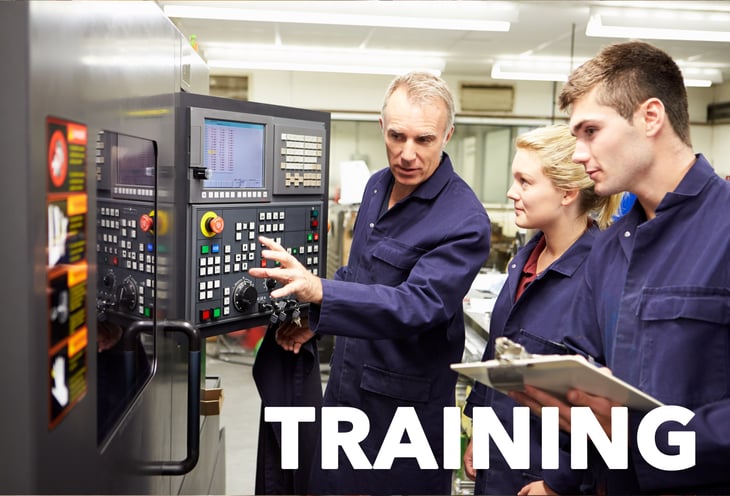
Good quality control starts with management, and companies must ensure that their managers and supervisors act as a mirror for proper adherence to quality control and safety measures. If management fails to oversee team members properly, quality control processes are not likely to be effective.
Having a good and effective management team begins with training. And that training needs to include a knowledge of how to establish and improve processes that relate to safety and quality assurance. Direct and specific training related to these topics can help companies ensure that managers understand the importance of improving quality control in manufacturing.
Here are some tips on the types of training and education managers should have as it relates to quality control measures.
General Training Topics
Be sure managers understand the overall importance of quality control and assurance. Emphasize the value these measures have as it relates to company success, customer satisfaction, and adherence to safety and compliance regulations.
Industry-Specific Training
Depending on the type of manufacturing a company does, there may be industry-specific regulations and standards that must be followed. Managers should have a clear understanding of which regulatory bodies oversee and regulate quality control and safety measures within their industry and should have complete and detailed knowledge of the requirements of each of these organizations.
Each of these agencies or organizations may provide industry-specific training for employees that companies can take advantage of to ensure their workforce is properly trained on these topics.
Create Your Own Training Process
If there are no industry-specific guidelines or standards set forth for a particular process, then companies should form their own set of standards. Managers should be able to understand, implement, and oversee employee performance as it relates to every individual set of standards in place.
Cross Train Your Staff
Managers and supervisors should be cross-trained so that they understand not only the standards and expectations of their departments but also the company as a whole. Companies should strive for managers who can oversee multiple departments, and therefore can step in and fill open spaces when needed.
Get Certified
Depending on the specific oversight committee, companies should seek to have managers certified in quality assurance training. There are various kinds of certifications that companies can implement at different levels across various industries.
Having a well-trained and certified management team helps to set an example for everyone in the company that quality control and safety are a priority for the company. It also ensures that managers don't fall through the cracks of a training program, providing a way for companies to guarantee a comprehensive understanding of the material.
Final Thoughts
Companies that seek to continuously improve quality control in the manufacturing industry have a distinct and measurable advantage over those that don't. Customers expect high-quality products when they decide to spend their hard-earned money on a product, and any even slight failure to provide that will result in them looking elsewhere in the future.
Implementing specific processes and procedures throughout every step of the production process is vital for companies who wish to consistently meet and exceed quality standards. With training, testing, planning, and strategy, manufacturing companies can maximize their potential to uphold quality control standards.
Continuous improvement is a concept that should relate to every aspect of a business. Companies should take advantage of all the tools available to them to improve their quality control standards and get better results.
“Passable” should never be good enough for a company that wants to succeed.
The goal should always be excellence.
FAQs From This Article
What is Quality Control in Manufacturing?
- Quality control in manufacturing involves systematic processes aimed at ensuring products meet predefined quality standards. It encompasses various techniques and methodologies to identify defects in products and prevent them from reaching the customer.
Why is Quality Control Important in Manufacturing?
- Quality control is crucial in manufacturing because it helps maintain high-quality standards, reduces waste, ensures customer satisfaction, and complies with industry regulations. It's essential for building a reputable brand and maintaining competitive advantage.
How Can Technology Improve Quality Control in Manufacturing?
- Technology, such as digital work instructions, real-time monitoring systems, and purpose-built quality control systems can significantly enhance quality control. These technologies provide more accurate, consistent, and efficient means of monitoring and improving product quality.
What are Some Common Quality Control Techniques in Manufacturing?
- Common techniques include statistical process control, quality audits, failure testing, and Six Sigma methodologies. These techniques help identify and mitigate errors in the manufacturing process, ensuring the final product meets the desired quality standards.
Topic(s):
Standard Work
65% Faster Changeovers
Learn how a Dozuki customer reduced changeover time and MTBF by over 60%.
Related Posts
View All Posts
Standard Work
Free Standard Operating Procedure & Work Instruction Templates
4 min read
Standard operating procedure (SOP) and work instruction templates help standardize processes and present information consistently. We’ve seen thousands of examples of these...
Continue Reading
Standard Work
Quality Assurance in Manufacturing: An In-Depth Guide to Achieve Customer Confidence
23 min read
It’s time to talk about quality. In this industry, quality is everything, and competition between manufacturers is fierce. Table of Content 1. Key Principles of Quality...
Continue Reading
Standard Work
Best Practices of Food Manufacturing Hygiene Standards
33 min read
Food manufacturing companies have a responsibility to their customers to maintain high-quality control measures and hygiene standards. These practices are necessary to ensure...
Continue Reading



